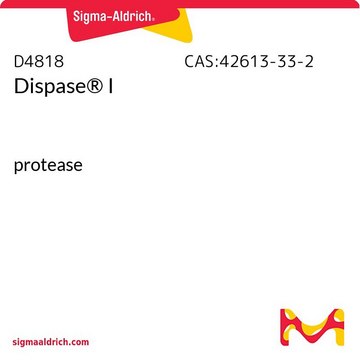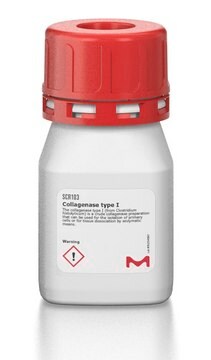詳細
The Collagenase-Deoxyribonuclease I-Dispase II blend is a tissue dissociation enzyme cocktail for cell isolation. The tissue dissociation process consists in the release of functional and viable cells from animal tissue, with minimal impact on the cell’s viability. The main reagent used for the tissue dissociation process is Collagenase. Collagenases are enzymes that break down the native collagen that holds animal tissues together. The second enzyme found in our blend is Deoxyribonuclease I (DNase I). DNase I, is an endonuclease of the DNase family, with a specific role for the degradation of DNA. DNase I is one of the most well characterized endonucleases of mammalian origin. During tissue dissociation, parts of the cells are lysed resulting in a release of DNA. Monomolecular DNA may cause clumping of cells, so addition of DNase I to our blend leads to a degradation of this extracellular DNA, thereby avoiding the loss of cells from undesired clumping. The third enzyme found in our blend is Dispase II. Diapse II is a non-mammalian animal origin free. Its mild proteolytic action makes the enzyme especially suitable for the preparation of primary cells and as a secondary enzyme in cell isolation and tissue dissociation applications. It is commonly used to separate skin epidermis from dermis leaving intact epithelial sheets and stem cell, hepatocyte and other cell isolation applications. This collagenase blend allow is a significantly less harmful cell isolation preventing unwanted cell clumping without cell membrane damage.
生物化学的/生理学的作用
Collagenase: Effective release of cells from tissue requires the action of collagenase enzymes. Collagenase is activated by four-gram atom calcium (Ca2+) per mole enzyme. The pH optimum is 6.3-8.8. The enzyme is typically used to digest the connective components in tissue samples to liberate individual cells. Collagenase treatment can cause some cells to die. Typically, concentrations varying from 0.1 to 5 mg/mL are used for digestion. The duration of reaction varies from 15 minutes to several hours and yields satisfactory cell dissociation without causing too much cell death. Hyaluronidase: degrades hyaluronan and randomly cleave β-N-acetylhexosamine-(1−4)-glycosidic bonds in hyaluronic acid, chondroitin, and chondroitin sulfates.
調製ノート
For a working concentration of: Collagenase of 1 mg/ml, Deoxyribonuclease I of 0.1 mg/ml and Dispase II of ≥ 2 units/ml, reconstitute the lyophilized powder with 10 ml of Hank’s Balanced Salt solution with sodium bicarbonate, without phenol red, calcium chloride and magnesium sulfate (#H6648).











